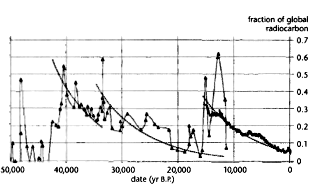What Tony DeRegnaucourt told me was that only the Dalton and Fort Paine quarries continued in use in the east
during Phase 1.
Afterwards, Agate Basin forms predominate in the west.
Both seem to check out.
FWIW, I've suspected a glitch in the transmission there since reading your book. This is why : Fort Paine is a type of chert (actually, a geological formation that's exposed here and there going Northward up the Appalachians from Alabama). The best of it is very good quality chert indeed. As I understand it (and
I'm not a geologist nor interested enough in geology to get on top of what all's involved) some outcroppings of it have different names assigned (e.g., Hopkinsville Chert, which is a variety of Ste. Genevieve Chert, which, I think is Ft. Paine formation).
The other principal paleo chert used in that general area was Dover Chert. It, too, was a Paleo mainstay. Stuff like Paoli Chert figures into the picture as well. But what isn't clear (to me, at least) is whether this was a stand-alone variety or a subspecies of one of the big two flying under independent colors.
Dalton was a culture (a different technology -- note that core/blade technology seems to be absent entirely in it -- with a different adaptation to the environment) that followed the Paleo era, although people sometimes assign it to Late Paleo. But overall, it seems to mark the beginning of geographically limited territoriality in time, where (in contrast to the Paleo era when people were wide-ranging) one band settled an area and made do with whatever resources it provided them. It contrasts with Clovis also in being geographically limited rather than pan-continental. (Beginning with Early Archaic, cultural territories begin to shrink. And shrink. And shrink).
"Dalton" is, of course, also a point type.
The stinky part is that nobody seems to be pursuing the Late Paleo era with much enthusiasm. Sites are very few, and a lot of changes (starting with climate) were going on during it. Late Paleo in the SE pretty much correlates with the "missing 1,400 years in New York). I believe it was Tankersley (
The Archaeology of Kentucky -- an Update) that noted that the shift from Early Paleo (essentially Clovis) (Yahnig's
Little River Complex for example) to Middle Paleo (frustratingly undescribed other than to note an increase in the prevalence of limaces and spurred, triangular endscrapers) also marks a shift to a wider range of lithic materials. (One of which would be Buffalo River Chert. But if that's a variety of Fort Paine, we're back to square one . . .) (LOTS of terminological confusion). And, going by examples of Late Paleo points & tools I've seen (Quad, Beaver Lake, et al.), they were pretty much using whatever chert was handy and usable.
Agate Basin (another point type) was one of a number of cultures (or whatever it's hip to call them this week) that evolved in the West and drifted (North) Eastward during what Dragoo insightfully characterised as the Aquaplano era. The pluvial lakes & grasslands in the West were tuning into deserts, and the fauna following the retreating margin of habitability. (People naturally following the animals). It's thus that you end up with native Western point types like Angostura, Agate Basin, Eden and Folsom points in Wisconsin, Illinois, Missouri & even further (North)East. Archaeologically, it's a black hole and pretty much lives up to the Marine Core's famous "
Cluster Experience" description of such an event overall.
Temporally, in the West, Folsom marks the end of Paleo, while at least some others properly fall under the Paleoarchaic heading (or should). In the East, along with HiLo, Holcombe and the rest, it seems to be what's currently called Late Paleo.
At any rate, that's the backdrop against which your statement appears. It's not a "criticism" of it.



